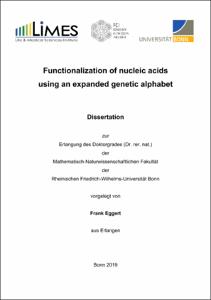Functionalization of nucleic acids using an expanded genetic alphabet

Functionalization of nucleic acids using an expanded genetic alphabet

| dc.contributor.advisor | Famulok, Michael | |
| dc.contributor.author | Eggert, Frank | |
| dc.date.accessioned | 2020-04-27T14:25:44Z | |
| dc.date.available | 2022-11-01T23:00:20Z | |
| dc.date.issued | 06.02.2020 | |
| dc.identifier.uri | https://hdl.handle.net/20.500.11811/8271 | |
| dc.description.abstract | RNA performs key functions on all levels of life including coding, regulation, and catalysis. These characteristics crucially depend on sensitive three-dimensional structure development.
Functional engineering of RNA is a prerequisite to enable non-disruptive probing for the visualization of target sequences and to gather reliable insights into essential features such as their localization and constitution. This thesis centrally involves genetic code expansion with an unnatural base pair to design novel tools for the site-specific manipulation of functional non-coding RNA. Particularly, a cyclopropene-equipped unnatural ribonucleoside triphosphate was created that can be applied to efficiently prepare modified RNA via template-directed in vitro transcription. Several site-specific labeling approaches were established for the production of functional RNA sequences independent of their length. The cyclopropene moiety serves as highly reactive and minimum-sized handle for ultra-mild post-transcriptional attachment of virtually any reporter group to RNA by means of cell-compatible click chemistry. Furthermore, distance measurements using electron paramagnetic resonance spectroscopy on highly structured RNA transcripts were facilitated by the introduction of nitroxide spin labels via genetic alphabet expansion transcription. This technique allows investigating structural dynamics of large complexly folded RNAs in nanometer range under solution conditions. Additionally, significant synthetic progress towards a photoswitchable nucleotide as part of an artificial base pair was achieved. Intriguing applications to spatially and temporally control RNA interactions are envisioned upon completion of this project. The valuable results presented in this study significantly contribute to the continuous enrichment of knowledge about non-coding RNA molecules that are ubiquitously involved in transmission and expression of genetic information. | en |
| dc.language.iso | eng | |
| dc.rights | In Copyright | |
| dc.rights.uri | http://rightsstatements.org/vocab/InC/1.0/ | |
| dc.subject.ddc | 540 Chemie | |
| dc.title | Functionalization of nucleic acids using an expanded genetic alphabet | |
| dc.type | Dissertation oder Habilitation | |
| dc.publisher.name | Universitäts- und Landesbibliothek Bonn | |
| dc.publisher.location | Bonn | |
| dc.rights.accessRights | openAccess | |
| dc.identifier.urn | https://nbn-resolving.org/urn:nbn:de:hbz:5-57261 | |
| ulbbn.pubtype | Erstveröffentlichung | |
| ulbbnediss.affiliation.name | Rheinische Friedrich-Wilhelms-Universität Bonn | |
| ulbbnediss.affiliation.location | Bonn | |
| ulbbnediss.thesis.level | Dissertation | |
| ulbbnediss.dissID | 5726 | |
| ulbbnediss.date.accepted | 15.01.2020 | |
| ulbbnediss.institute | Mathematisch-Naturwissenschaftliche Fakultät : Fachgruppe Chemie / Kekulé-Institut für Organische Chemie und Biochemie | |
| ulbbnediss.fakultaet | Mathematisch-Naturwissenschaftliche Fakultät | |
| dc.contributor.coReferee | Schiemann, Olav | |
| ulbbnediss.date.embargoEndDate | 01.11.2022 | |
| ulbbnediss.contributor.gnd | 1270462229 |
Dateien zu dieser Ressource
Das Dokument erscheint in:
-
E-Dissertationen (4335)




